Religion in the United States
Religion in the United States is diverse with Christianity being the majority religion, although declining at rapid pace.[1] Various religious faiths have flourished within the United States. Slightly over 50% of Americans report that religion plays a very important role in their lives, a proportion unique among developed countries.[2] Freedom of religion in the United States is guaranteed in the First Amendment to the United States Constitution.
| This article is part of a series on the |
| Culture of the United States of America |
|---|
| Society |
| Arts and literature |
|
| Other |
| Symbols |
|
United States portal |
Historically, the United States has always been marked by religious pluralism and diversity, beginning with various native beliefs of the pre-colonial time. In colonial times, Anglicans, Catholics and mainline Protestants, as well as Jews, arrived from Europe. Eastern Orthodoxy has been present since the Russian colonization of Alaska. Various dissenting Protestants, who left the Church of England, greatly diversified the religious landscape. The Great Awakenings gave birth to multiple evangelical Protestant denominations; membership in Methodist and Baptist churches increased drastically in the Second Great Awakening. In the 18th century, deism found support among American upper classes and thinkers. The Episcopal Church, splitting from the Church of England, came into being in the American Revolution. New Protestant branches like Adventism emerged; Restorationists and other Christians like the Jehovah's Witnesses, the Latter Day Saint movement, Churches of Christ and Church of Christ, Scientist, as well as Unitarian and Universalist communities all spread in the 19th century. Pentecostalism emerged in the early 20th century as a result of the Azusa Street Revival. Scientology emerged in the 1950s. Unitarian Universalism resulted from the merge of Unitarian and Universalist churches in the 20th century. Since the 1990s, the religious share of Christians has decreased, while Buddhism, Hinduism, Islam, Sikhism, and other religions have spread, mainly from immigration. Protestantism, historically dominant, ceased to be the religious category of the majority in the early 2010s.
Christianity is the largest religion in the United States with the various Protestant Churches having the most adherents. In 2019, Christians represent 65% of the total population, 43% identifying as Protestants, 20% as Catholics, and 2% as Mormons, people with no formal religious identity at 26% of the total population, Judaism is the second-largest religion in the U.S., practiced by 2% of the population, followed by Islam, Buddhism, and Hinduism with 1% each one.[1] Mississippi is the most religious state in the country, with 63% of its adult population described as very religious, saying that religion is important to them and attending religious services almost every week, while New Hampshire, with only 20% of its adult population described as very religious, is the least religious state.[3] The most religious state or territory of the United States is American Samoa (99.3% religious).[4]
History
From early colonial days, when some English and German settlers moved in search of religious freedom, America has been profoundly influenced by religion.[5] That influence continues in American culture, social life, and politics.[6] Several of the original Thirteen Colonies were established by settlers who wished to practice their own religion within a community of like-minded people: the Massachusetts Bay Colony was established by English Puritans (Congregationalists), Pennsylvania by British Quakers, Maryland by English Catholics, and Virginia by English Anglicans. Despite these, and as a result of intervening religious strife and preference in England[7] the Plantation Act 1740 would set official policy for new immigrants coming to British America until the American Revolution.
The text of the First Amendment to the country's Constitution states that "Congress shall make no law respecting an establishment of religion, or prohibiting the free exercise thereof; or abridging the freedom of speech, or of the press; or the right of the people peaceably to assemble, and to petition the Government for a redress of grievances." It guarantees the free exercise of religion while also preventing the government from establishing a state religion. However, the states were not bound by the provision and as late as the 1830s Massachusetts provided tax money to local Congregational churches.[8] The Supreme Court since the 1940s has interpreted the Fourteenth Amendment as applying the First Amendment to the state and local governments.
President John Adams and a unanimous Senate endorsed the Treaty of Tripoli in 1797 that stated: "the Government of the United States of America is not, in any sense, founded on the Christian religion."[9]
Expert researchers and authors have referred to the United States as a "Protestant nation" or "founded on Protestant principles,"[10][11][12][13] specifically emphasizing its Calvinist heritage.[14][15][16]
The modern official motto of the United States of America, as established in a 1956 law signed by President Dwight D. Eisenhower, is "In God We Trust".[17][18][19] The phrase first appeared on U.S. coins in 1864.[18]
According to a 2002 survey by the Pew Research Center, nearly 6 in 10 Americans said that religion plays an important role in their lives, compared to 33% in Great Britain, 27% in Italy, 21% in Germany, 12% in Japan, and 11% in France. The survey report stated that the results showed America having a greater similarity to developing nations (where higher percentages say that religion plays an important role) than to other wealthy nations, where religion plays a minor role.[2]
In 1963, 90% of U.S. adults claimed to be Christians while only 2% professed no religious identity.[20] In 2016, 73.7% identified as Christians while 18.2% claimed no religious affiliation.[21]
Freedom of religion

The United States federal government was the first national government to have no official state-endorsed religion.[23] However, some states had established religions in some form until the 1830s.
Modeling the provisions concerning religion within the Virginia Statute for Religious Freedom, the framers of the Constitution rejected any religious test for office, and the First Amendment specifically denied the federal government any power to enact any law respecting either an establishment of religion or prohibiting its free exercise, thus protecting any religious organization, institution, or denomination from government interference. The decision was mainly influenced by European Rationalist and Protestant ideals, but was also a consequence of the pragmatic concerns of minority religious groups and small states that did not want to be under the power or influence of a national religion that did not represent them.[24]
Abrahamic religions
Christianity
The most popular religion in the U.S. is Christianity, comprising the majority of the population (73.7% of adults in 2016).[25] According to the Association of Statisticians of American Religious Bodies newsletter published March 2017, based on data from 2010, Christians were the largest religious population in all 3,143 counties in the country.[26] Roughly 48.9% of Americans are Protestants, 23.0% are Catholics, 1.8% are Mormons (members of The Church of Jesus Christ of Latter-day Saints).[25] Christianity was introduced during the period of European colonization.
According to a 2012 review by the National Council of Churches, the five largest denominations are:[27]
- The Catholic Church, 68,202,492 members
- The Southern Baptist Convention, 16,136,044 members
- The United Methodist Church, 7,679,850 members
- The Church of Jesus Christ of Latter-day Saints, 6,157,238 members
- The Church of God in Christ, 5,499,875 members
The Southern Baptist Convention, with over 16 million adherents, is the largest of more than 200[28] distinctly named Protestant denominations.[29] In 2007, members of evangelical churches comprised 26% of the American population, while another 18% belonged to mainline Protestant churches, and 7% belonged to historically black churches.[30]
A 2015 study estimates some 450,000 Christian believers from a Muslim background in the country, most of them belonging to some form of Protestantism.[31] In 2010 there were approximately 180,000 Arab Americans and about 130,000 Iranian Americans who converted from Islam to Christianity. Dudley Woodbury, a Fulbright scholar of Islam, estimates that 20,000 Muslims convert to Christianity annually in the United States.[32]
Mainline Protestant denominations
Historians agree that members of mainline Protestant denominations have played leadership roles in many aspects of American life, including politics, business, science, the arts, and education. They founded most of the country's leading institutes of higher education.[33] According to Harriet Zuckerman, 72% of American Nobel Prize Laureates between 1901 and 1972, have identified from Protestant background.[34]
Episcopalians[35] and Presbyterians[36] tend to be considerably wealthier and better educated than most other religious groups, and numbers of the most wealthy and affluent American families as the Vanderbilts[35] and Astors,[35] Rockefeller,[37] Du Pont, Roosevelt, Forbes, Whitneys,[35] Morgans[35] and Harrimans are Mainline Protestant families,[35] though those affiliated with Judaism are the wealthiest religious group in the United States[38][39] and those affiliated with Catholicism, owing to sheer size, have the largest number of adherents of all groups in the top income bracket.[40]
Some of the first colleges and universities in America, including Harvard,[41] Yale,[42] Princeton,[43] Columbia,[44] Dartmouth,[45] Williams, Bowdoin, Middlebury,[46] and Amherst, all were founded by mainline Protestant denominations. By the 1920s most had weakened or dropped their formal connection with a denomination. James Hunter argues that:
- The private schools and colleges established by the mainline Protestant denominations, as a rule, still want to be known as places that foster values, but few will go so far as to identify those values as Christian.... Overall, the distinctiveness of mainline Protestant identity has largely dissolved since the 1960s.[47]
Roman Catholicism
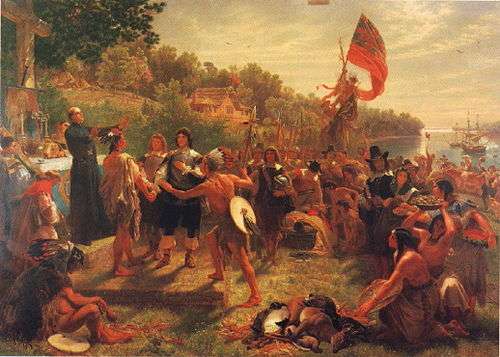
While the Puritans were securing their Commonwealth, members of the Catholic church in England were also planning a refuge, "for they too were being persecuted on account of their religion."[49] Among those interested in providing a refuge for Catholics was the second Lord of Baltimore, George Calvert, who established Maryland, a "Catholic Proprietary," in 1634,[49] more than sixty years after the founding of the Spanish Florida mission of St. Augustine.[50] Though small in number in the beginning, Catholicism grew over the centuries to become the largest single denomination in the US, primarily through immigration, but also through the acquisition of continental territories under the jurisdiction of French and Spanish Catholic powers.[51] Though the European Catholic and indigenous population of these former territories were small,[52] the material cultures there, the original mission foundations with their canonical Catholic names, are still recognized today (as they were formerly known) in any number of cities in California, New Mexico and Louisiana. (The most recognizable cities of California, for example, are named after Catholic saints.)
As the number of Catholics increased, they built up a vast system of schools (from primary schools to universities) and hospitals. The first US Catholic university, Georgetown University, was founded in 1789. Since then, the Catholic church has founded hundreds of other colleges and universities, along with thousands of primary and secondary schools. Schools like the University of Notre Dame is ranked best in its state (Indiana) as Georgetown University is ranked best in the District of Columbia. 12 Catholic universities are also ranked among the top 100 universities in the US.[53]
Christian settlers
Beginning around 1600 European settlers introduced Anglican and Puritan religion, as well as Baptist, Presbyterian, Lutheran, Quaker, and Moravian denominations.[54]
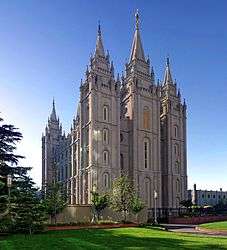
Beginning in the 16th century, the Spanish (and later the French and English) introduced Catholicism. From the 19th century to the present, Catholics moved to the US in large numbers due to immigration of Italians, Hispanics, Portuguese, French, Polish, Irish, Highland Scots, Dutch, Flemish, Hungarians, Germans, Lebanese (Maronite), and other ethnic groups.
During the 19th century, two main branches of Eastern Christianity also arrived to America. Eastern Orthodoxy was brought to America by Greek, Russian, Ukrainian, Serbian, and other immigrant groups, mainly from Eastern Europe. In the same time, several immigrant groups from the Middle East, mainly Armenians, Copts and Syriacs, brought Oriental Orthodoxy to America.[55][56]
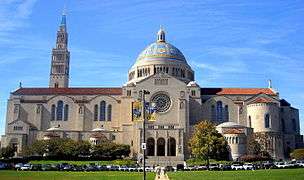
Several Christian groups were founded in America during the Great Awakenings. Interdenominational evangelicalism and Pentecostalism emerged; new Protestant denominations such as Adventism; non-denominational movements such as the Restoration Movement (which over time separated into the Churches of Christ, the Christian churches and churches of Christ, and the Christian Church (Disciples of Christ)); Jehovah's Witnesses (called "Bible Students" in the latter part of the 19th century); and The Church of Jesus Christ of Latter-day Saints (Mormonism).
The strength of various sects varies greatly in different regions of the country, with rural parts of the South having many evangelicals but very few Catholics (except Louisiana and the Gulf Coast, and from among the Hispanic community, both of which consist mainly of Catholics), while urbanized areas of the north Atlantic states and Great Lakes, as well as many industrial and mining towns, are heavily Catholic, though still quite mixed, especially due to the heavily Protestant African-American communities. In 1990, nearly 72% of the population of Utah was Mormon, as well as 26% of neighboring Idaho.[57] Lutheranism is most prominent in the Upper Midwest, with North Dakota having the highest percentage of Lutherans (35% according to a 2001 survey).[58]
The largest religion, Christianity, has proportionately diminished since 1990. While the absolute number of Christians rose from 1990 to 2008, the percentage of Christians dropped from 86% to 76%.[59] A nationwide telephone interview of 1,002 adults conducted by The Barna Group found that 70% of American adults believe that God is "the all-powerful, all-knowing creator of the universe who still rules it today", and that 9% of all American adults and 0.5% young adults hold to what the survey defined as a "biblical worldview".[60]
Episcopalian, Presbyterian, Eastern Orthodox and United Church of Christ members[61] have the highest number of graduate and post-graduate degrees per capita of all Christian denominations in the United States,[62][63] as well as the most high-income earners.[64][65] However, owing to the sheer size or demographic head count of Catholics, more individual Catholics have graduate degrees and are in the highest income brackets than have or are individuals of any other religious community.[66]
Judaism
After Christianity, Judaism is the next largest religious affiliation in the US, though this identification is not necessarily indicative of religious beliefs or practices.[59] There are between 5.3 and 6.6 million Jews. A significant number of people identify themselves as American Jews on ethnic and cultural grounds, rather than religious ones. For example, 19% of self-identified American Jews do not believe God exists.[67] The 2001 ARIS study projected from its sample that there are about 5.3 million adults in the American Jewish population: 2.83 million adults (1.4% of the U.S. adult population) are estimated to be adherents of Judaism; 1.08 million are estimated to be adherents of no religion; and 1.36 million are estimated to be adherents of a religion other than Judaism.[68] ARIS 2008 estimated about 2.68 million adults (1.2%) in the country identify Judaism as their faith.[59] According to a 2017 study, Judaism is the religion of approximately 2% of the American population.[21]
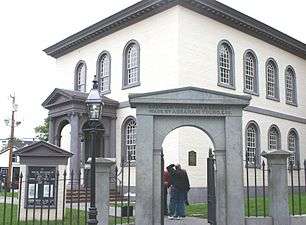
Jews have been present in what is now the US since the 17th century, and specifically allowed since the British colonial Plantation Act 1740. Although small Western European communities initially developed and grew, large-scale immigration did not take place until the late 19th century, largely as a result of persecutions in parts of Eastern Europe. The Jewish community in the United States is composed predominantly of Ashkenazi Jews whose ancestors emigrated from Central and Eastern Europe. There are, however, small numbers of older (and some recently arrived) communities of Sephardi Jews with roots tracing back to 15th century Iberia (Spain, Portugal, and North Africa). There are also Mizrahi Jews (from the Middle East, Caucasia and Central Asia), as well as much smaller numbers of Ethiopian Jews, Indian Jews, Kaifeng Jews and others from various smaller Jewish ethnic divisions. Approximately 25% of the Jewish American population lives in New York City.[69]
According to the Association of Statisticians of American Religious Bodies newsletter published March, 2017, based on data from 2010, Jews were the largest minority religion in 231 counties out of the 3143 counties in the country.[26] According to a 2014 survey conducted by the Pew Forum on Religion and Public life, 1.7% of adults in the U.S. identify Judaism as their religion. Among those surveyed, 44% said they were Reform Jews, 22% said they were Conservative Jews, and 14% said they were Orthodox Jews.[70][71] According to the 1990 National Jewish Population Survey, 38% of Jews were affiliated with the Reform tradition, 35% were Conservative, 6% were Orthodox, 1% were Reconstructionists, 10% linked themselves to some other tradition, and 10% said they are "just Jewish".[72]
The Pew Research Center report on American Judaism released in October 2013 revealed that 22% of Jewish Americans say they have "no religion" and the majority of respondents do not see religion as the primary constituent of Jewish identity. 62% believe Jewish identity is based primarily in ancestry and culture, only 15% in religion. Among Jews who gave Judaism as their religion, 55% based Jewish identity on ancestry and culture, and 66% did not view belief in God as essential to Judaism.[73]
A 2009 study estimated the Jewish population (including both those who define themselves as Jewish by religion and those who define themselves as Jewish in cultural or ethnic terms) to be between 6.0 and 6.4 million.[74] According to a study done in 2000 there were an estimated 6.14 million Jewish people in the country, about 2% of the population.[75]
According to the 2001 National Jewish Population Survey, 4.3 million American Jewish adults have some sort of strong connection to the Jewish community, whether religious or cultural.[76] Jewishness is generally considered an ethnic identity as well as a religious one. Among the 4.3 million American Jews described as "strongly connected" to Judaism, over 80% have some sort of active engagement with Judaism, ranging from attendance at daily prayer services on one end of the spectrum to attending Passover Seders or lighting Hanukkah candles on the other. The survey also discovered that Jews in the Northeast and Midwest are generally more observant than Jews in the South or West.
The Jewish American community has higher household incomes than average, and is one of the best educated religious communities in the United States.[61]
Islam
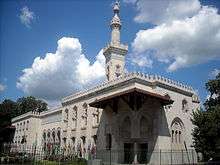
Islam is probably the third largest religion in numbers in the United States, after Christianity and Judaism, followed, according to Gallup, by 0.8% of the population in 2016.[25] Hinduism and Buddhism follow it closely in numbers (in 2014 the large scale Religious Life Survey found Islam with 0.9% and the other two with 0.7% each[61]). According to the Association of Statisticians of American Religious Bodies newsletter published in March 2017, based on data from 2010, Muslims were the largest minority religion in 392 counties out of the 3143 counties in the country.[26] According to the Institute for Social Policy and Understanding (ISPU) in 2018, there are approximately 3.45 million Muslims living in the United States, with 2.05 million adults, and the rest being children.[77] Across faith groups, ISPU found in 2017 that Muslims were most likely to be born outside of the US (50%), with 36% having undergone naturalization. American Muslims are also America's most diverse religious community with 25% identifying as black or African American, 24% identifying as white, 18% identifying as Asian/Chinese/Japanese, 18% identifying as Arab, and 5% identifying as Hispanic.[78] In addition to diversity, Americans Muslims are most likely to report being low income, and among those who identify as middle class, the majority are Muslim women, not men. Although American Muslim education levels are similar to other religious communities, namely Christians, within the Muslim American population, Muslim women surpass Muslim men in education, with 31% of Muslim women having graduated from a four-year university. 90% of Muslim Americans identify as straight.[78]
Islam in America effectively began with the arrival of African slaves. It is estimated that about 10% of African slaves transported to the United States were Muslim.[79] Most, however, became Christians, and the United States did not have a significant Muslim population until the arrival of immigrants from Arab and East Asian Muslim areas.[80] According to some experts,[81] Islam later gained a higher profile through the Nation of Islam, a religious group that appealed to black Americans after the 1940s; its prominent converts included Malcolm X and Muhammad Ali.[82][83] The first Muslim elected to Congress was Keith Ellison in 2006,[84] followed by André Carson in 2008.[85]
Out of all religious groups surveyed by ISPU, Muslims were found to be the most likely to report experiences of religious discrimination (61%). That can also be broken down when looking at gender (with Muslim women more likely than Muslim men to experience racial discrimination), age (with young people more likely to report experiencing racial discrimination than older people), and race, (with Arab Muslims the most likely to report experiencing religious discrimination). Muslims born in the United States are more likely to experience all three forms of discrimination, gender, religious, and racial.[78]
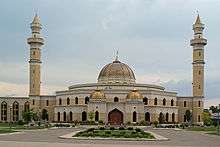
Research indicates that Muslims in the United States are generally more assimilated and prosperous than their counterparts in Europe.[86][87][88] Like other subcultural and religious communities, the Islamic community has generated its own political organizations and charity organizations.
ISPU also conducted a series of impact reports on Muslim Americans in both Michigan and New York City.[77] Looking at those two areas alone, the engagement of Muslim Americans is striking. 22.3% of Muslims live in New York City, the home of more mosques (285 total) than any other American city. Though just shy of 9% of the NYC population, Muslims make up over 12% of the city's pharmacists, lab technicians, and over 9% of all doctors. They make up 11.3% of all engineers, and are engaged at every level of civic life in the city, from senior adviser to the city government to directing outreach at the city council level. Nearly 10,000 NYC teachers are Muslim. Looking at NYC, it is evident that Muslim Americans are engaged and active in important sectors of American life. That level of engagement and dynamic interaction with the communities around them is further highlighted through the Michigan case study as well.
Bahá'í Faith
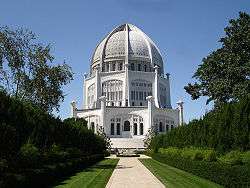
The United States has perhaps the second largest Bahá'í community in the world. First mention of the faith in the U.S. was at the inaugural Parliament of World Religions, which was held at the Columbian Exposition in Chicago in 1893. In 1894, Ibrahim George Kheiralla, a Syrian Bahá'í immigrant, established a community in the U.S. He later left the main group and founded a rival movement.[89] According to the Association of Statisticians of American Religious Bodies newsletter published March, 2017, based on data from 2010, Bahá'ís were the largest minority religion in 80 counties out of the 3143 counties in the country.[26]
Rastafarianism
Rastafarians began migrating to the United States in the 1950s, '60s and '70s from the religion's 1930s birthplace, Jamaica.[90][91] Marcus Garvey, who is considered a prophet by many Rastafarians,[92][93] rose to prominence and cultivated many of his ideas in the United States.
Dharmic religions
Buddhism
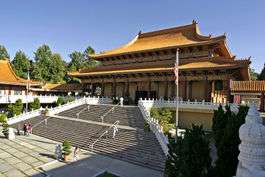
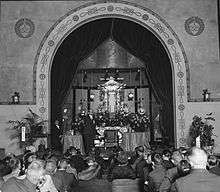
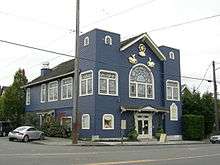
Buddhism entered the US during the 19th century with the arrival of the first immigrants from East Asia. The first Buddhist temple was established in San Francisco in 1853 by Chinese Americans.The first prominent US citizen to publicly convert to Buddhism was Henry Steel Olcott in 1880 who is still honored in Sri Lanka for these efforts. An event that contributed to the strengthening of Buddhism in the US was the Parliament of the World's Religions in 1893, which was attended by many Buddhist delegates sent from India, China, Japan, Vietnam, Thailand and Sri Lanka.
During the late 19th century Buddhist missionaries from Japan traveled to the US. During the same time period, US intellectuals started to take interest in Buddhism.
The early 20th century was characterized by a continuation of tendencies that had their roots in the 19th century. The second half, by contrast, saw the emergence of new approaches, and the move of Buddhism into the mainstream and making itself a mass and social religious phenomenon.[94][95]
According to a 2016 study, Buddhists are approximately 1% of the American population.[21] According to the Association of Statisticians of American Religious Bodies newsletter published March, 2017, based on data from 2010, Buddhists were the largest minority religion in 186 counties out of the 3143 counties in the country.[26]
Hinduism
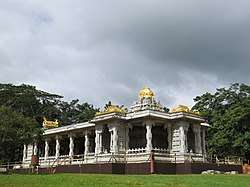
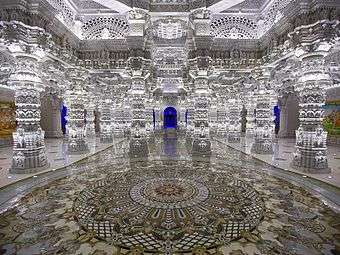
Hinduism is the fourth largest faith in the United States, representing approximately 1% of the population in 2016.[21] In 2001, there were an estimated 766,000 Hindus in the US, about 0.2% of the total population.[96][97]
The first time Hinduism entered the U.S. is not clearly identifiable. However, large groups of Hindus have immigrated from India, Sri Lanka, Nepal, Pakistan, Bangladesh, the Caribbean, southern Africa, eastern Africa, Singapore, Malaysia, Indonesia, Mauritius, Fiji, Europe, Australia, New Zealand, and other regions and countries since the enactment of the Immigration and Nationality Act of 1965. During the 1960s and 1970s Hinduism exercised fascination contributing to the development of New Age thought. During the same decades the International Society for Krishna Consciousness (a Vaishnavite Hindu reform organization) was founded in the US.In 2003, the Hindu American Foundation—a national institution protecting rights of the Hindu community of U.S.—was founded.
According to the Association of Statisticians of American Religious Bodies newsletter published March, 2017, based on data from 2010, Hindus were the largest minority religion in 92 counties out of the 3143 counties in the country.[26]
American Hindus have one of the highest rates of educational attainment and household income among all religious communities, and tend to have lower divorce rates.[61] Hindus also have higher acceptance towards homosexuality (71%), which is higher than the general public (62%).[98]
Jainism
Adherents of Jainism first arrived in the United States in the 20th century. The most significant time of Jain immigration was in the early 1970s. The United States has since become a center of the Jain Diaspora. The Federation of Jain Associations in North America is an umbrella organization of local American and Canadian Jain congregations to preserve, practice, and promote Jainism and the Jain way of life.[99]
Sikhism
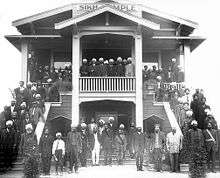
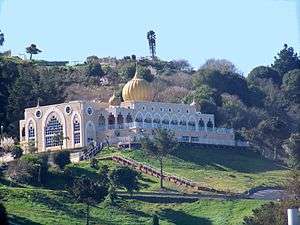
Sikhism is a religion originating from the Indian subcontinent which was introduced into the United States when, around the turn of the 20th century, Sikhs started emigrating to the United States in significant numbers to work on farms in California. They were the first community to come from India to the US in large numbers.[100] The first Sikh Gurdwara in America was built in Stockton, California, in 1912.[101] In 2007, there were estimated to be between 250,000 and 500,000 Sikhs living in the United States, with the largest populations living on the East and West Coasts, with additional populations in Detroit, Chicago, and Austin.[102][103]
The United States also has a number of non-Punjabi converts to Sikhism.[104]
East Asian religions
Taoism
In 2004 there were an estimated 56,000 Taoists in the US.[105] Taoism was popularized throughout the world through the writings and teachings of Lao Tzu and other Taoists as well as the practice of Qigong, Tai Chi Chuan and other Chinese martial arts.[106]
No religion
In 2016, approximately 18.2% of the Americans declared to be not religiously affiliated.[25]
Agnosticism, atheism, and humanism
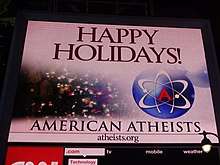
A 2001 survey directed by Dr. Ariela Keysar for the City University of New York indicated that, amongst the more than 100 categories of response, "no religious identification" had the greatest increase in population in both absolute and percentage terms. This category included atheists, agnostics, humanists, and others with no stated religious preferences. Figures are up from 14.3 million in 1990 to 34.2 million in 2008, representing an increase from 8% of the total population in 1990 to 15% in 2008.[59] A nationwide Pew Research study published in 2008 put the figure of unaffiliated persons at 16.1%,[97] while another Pew study published in 2012 was described as placing the proportion at about 20% overall and roughly 33% for the 18–29-year-old demographic.[107]
In a 2006 nationwide poll, University of Minnesota researchers found that despite an increasing acceptance of religious diversity, atheists were generally distrusted by other Americans, who trusted them less than Muslims, recent immigrants and other minority groups in "sharing their vision of American society". They also associated atheists with undesirable attributes such as amorality, criminal behavior, rampant materialism and cultural elitism.[108][109] However, the same study also reported that "The researchers also found acceptance or rejection of atheists is related not only to personal religiosity, but also to one's exposure to diversity, education and political orientation – with more educated, East and West Coast Americans more accepting of atheists than their Midwestern counterparts."[110] Some surveys have indicated that doubts about the existence of the divine were growing quickly among Americans under 30.[111]
On 24 March 2012, American atheists sponsored the Reason Rally in Washington, D.C., followed by the American Atheist Convention in Bethesda, Maryland. Organizers called the estimated crowd of 8,000–10,000 the largest-ever US gathering of atheists in one place.[112]
Deism
In the United States, Enlightenment philosophy (which itself was heavily inspired by deist ideals) played a major role in creating the principle of religious freedom, expressed in Thomas Jefferson's letters and included in the First Amendment to the United States Constitution. American Founding Fathers, or Framers of the Constitution, who were especially noted for being influenced by such philosophy of deism include Thomas Jefferson, Benjamin Franklin, Cornelius Harnett, Gouverneur Morris, and Hugh Williamson. Their political speeches show distinct deistic influence. Other notable Founding Fathers may have been more directly deist. These include Thomas Paine, James Madison, possibly Alexander Hamilton, and Ethan Allen.[113]
Belief in the existence of a god
Various polls have been conducted to determine Americans' actual beliefs regarding a god:
- In 2014 the Pew Research Center's Religious Landscape Study showed 63% of Americans believed in God and were "absolutely certain" in their view, while the figure rose to 89% including those who were agnostic.[114]
- A 2012 WIN-Gallup International poll showed that 5% of Americans considered themselves "convinced" atheists, which was a fivefold increase from the last time the survey was taken in 2005, and 5% said they did not know or else did not respond.[115]
- A 2012 Pew Research Center survey found that doubts about the existence of a god had grown among younger Americans, with 68% telling Pew they never doubt God's existence, a 15-point drop in five years. In 2007, 83% of American millennials said they never doubted God's existence.[111][116]
- A 2011 Gallup poll found 92% of Americans said yes to the basic question "Do you believe in God?", while 7% said no and 1% had no opinion.[117]
- A 2010 Gallup poll found 80% of Americans believe in a god, 12% believe in a universal spirit, 6% don't believe in either, 1% chose "other", and 1% had no opinion. 80% is a decrease from the 1940s, when Gallup first asked this question.
- A late 2009 online Harris poll of 2,303 U.S. adults (18 and older)[118] found that "82% of adult Americans believe in God", the same number as in two earlier polls in 2005 and 2007. Another 9% said they did not believe in God, and 9% said that they were not sure. It further concluded, "Large majorities also believe in miracles (76%), heaven (75%), that Jesus is God or the Son of God (73%), in angels (72%), the survival of the soul after death (71%), and in the resurrection of Jesus (70%). Less than half (45%) of adults believe in Darwin's theory of evolution but this is more than the 40% who believe in creationism..... Many people consider themselves Christians without necessarily believing in some of the key beliefs of Christianity. However, this is not true of born-again Christians. In addition to their religious beliefs, large minorities of adults, including many Christians, have "pagan" or pre-Christian beliefs such as a belief in ghosts, astrology, witches and reincarnation.... Because the sample is based on those who agreed to participate in the Harris Interactive panel, no estimates of theoretical sampling error can be calculated."
- A 2008 survey of 1,000 people concluded that, based on their stated beliefs rather than their religious identification, 69.5% of Americans believe in a personal God, roughly 12.3% of Americans are atheist or agnostic, and another 12.1% are deistic (believing in a higher power/non-personal God, but no personal God).[59]
- Mark Chaves, a Duke University professor of sociology, religion and divinity, found that 92% of Americans believed in God in 2008, but that significantly fewer Americans have great confidence in their religious leaders than a generation ago.[119]
- According to a 2008 ARIS survey, belief in God varies considerably by region. The lowest rate is in the West with 59% reporting a belief in God, and the highest rate is in the South at 86%.[120]
Spiritual but not religious
"Spiritual but not religious" (SBNR) is self-identified stance of spirituality that takes issue with organized religion as the sole or most valuable means of furthering spiritual growth. Spirituality places an emphasis upon the wellbeing of the "mind-body-spirit,"[121] so holistic activities such as tai chi, reiki, and yoga are common within the SBNR movement.[122] In contrast to religion, spirituality has often been associated with the interior life of the individual.[123]
One fifth of the US public and a third of adults under the age of 30 are reportedly unaffiliated with any religion, however they identify as being spiritual in some way. Of these religiously unaffiliated Americans, 37% classify themselves as spiritual but not religious.[124]
Others
Many other religions are represented in the United States, including Shinto, Caodaism, Thelema, Santería, Kemetism, Religio Romana, Zoroastrianism, Vodou, Pastafarianism, and many forms of New Age spirituality.
Native American religions
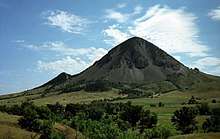
Native American religions historically exhibited much diversity, and are often characterized by animism or panentheism.[125] The membership of Native American religions in the 21st century comprises about 9,000 people.[126]
Neopaganism
Neopaganism in the United States is represented by widely different movements and organizations. The largest Neopagan religion is Wicca, followed by Neo-Druidism.[127][128] Other neopagan movements include Germanic Neopaganism, Celtic Reconstructionist Paganism, Hellenic Polytheistic Reconstructionism, and Semitic neopaganism.
Druidry
According to the American Religious Identification Survey (ARIS), there are approximately 30,000 druids in the United States.[129] Modern Druidism arrived in North America first in the form of fraternal Druidic organizations in the nineteenth century, and orders such as the Ancient Order of Druids in America were founded as distinct American groups as early as 1912. In 1963, the Reformed Druids of North America (RDNA) was founded by students at Carleton College, Northfield, Minnesota. They adopted elements of Neopaganism into their practices, for instance celebrating the festivals of the Wheel of the Year.[130]
Wicca
Wicca advanced in North America in the 1960s by Raymond Buckland, an expatriate Briton who visited Gardner's Isle of Man coven to gain initiation.[131] Universal Eclectic Wicca was popularized in 1969 for a diverse membership drawing from both Dianic and British Traditional Wiccan backgrounds.[132]
Nordic Paganism
Nordic Paganism is the umbrella term for polytheistic followers of the Proto-Norse period religions involving the Nordic pantheon of gods. This pantheon includes gods such as the Æsir; Odin, Thor, Loki, Sif, Heimdallr, Baldr, and Týr, as well as goddesses that include Vanir; Freyja, Freyr, Njörðr, and Nerthus. The followers of Nordic Paganism include Odinists, Tyrists, Lokians, Asatru, and practitioners of Seiðr, among other varying followers. Nordic Pagans follow the teachings of the Hávamál. This old text, along with the Prose Edda and Poetic Edda, gives the basis for Norse mythology, stories, legends, and beliefs.
Norse mythology is portrayed in popular culture and Nordic symbols and teachings are also used by many white supremacy groups. This use has prompted some prisons to ban the wearing of these symbols, such as Mjölnir, by inmates due to their gang affiliation.
New Thought Movement
A group of churches which started in the 1830s in the United States is known under the banner of "New Thought". These churches share a spiritual, metaphysical and mystical predisposition and understanding of the Bible and were strongly influenced by the Transcendentalist movement, particularly the work of Ralph Waldo Emerson. Another antecedent of this movement was Swedenborgianism, founded on the writings of Emanuel Swedenborg in 1787.[133] The New Thought concept was named by Emma Curtis Hopkins ("teacher of teachers") after Hopkins broke off from Mary Baker Eddy's Church of Christ, Scientist. The movement had been previously known as the Mental Sciences or the Christian Sciences. The three major branches are Religious Science, Unity Church and Divine Science.
Unitarian Universalism
Unitarian Universalists (UUs) are among the most liberal of all religious denominations in America.[134] The shared creed includes beliefs in inherent dignity, a common search for truth, respect for beliefs of others, compassion, and social action.[135] They are unified by their shared search for spiritual growth and by the understanding that an individual's theology is a result of that search and not obedience to an authoritarian requirement.[136] UUs have historical ties to anti-war, civil rights, and LGBT rights movements,[137] as well as providing inclusive church services for the broad spectrum of liberal Christians, liberal Jews, secular humanists, LGBT, Jewish-Christian parents and partners, Earth-centered/Wicca, and Buddhist meditation adherents.[138]
Major religious movements founded in the United States
Christian
.jpg)
.jpg)
- Pentecostalism – movement which emphasizes the role of the Holy Spirit, finds its historic roots in the Azusa Street Revival in Los Angeles from 1904 to 1906, sparked by Charles Parham. It is estimated to have over 279 million followers worldwide, many in Africa and South America.[139]
- Adventism – began as an inter-denominational movement. Its most vocal leader was William Miller, who in the 1830s in New York became convinced of an imminent Second Coming of Jesus. The most prominent modern group to emerge from this is the Seventh-day Adventists.
- The Latter Day Saint movement founded in 1830 by Joseph Smith in upstate New York – a product of the Christian revivalist movement of the Second Great Awakening and based in Christian primitivism. Multiple Latter Day Saint denominations can be found throughout the United States. The Church of Jesus Christ of Latter-day Saints (LDS Church), the largest denomination, is headquartered in Salt Lake City, Utah, and it has members in many countries. The Community of Christ, the second-largest denomination, is headquartered in Independence, Missouri. Worldwide they claim about 15 million members.
- Jehovah's Witnesses – originated with the religious movement known as Bible Students, which was founded in Pennsylvania in the late 1870s by Charles Taze Russell. In their early years, the Bible Students were loosely connected with Adventism, and the Jehovah's Witnesses still share some similarities with it. They claim about 7.69 million active members worldwide.
- Christian Science – founded by Mary Baker Eddy in the late 19th century. The church claims some 400,000 members worldwide.
- Churches of Christ/Disciples of Christ – a restoration movement with no governing body. The Restoration Movement solidified as a historical phenomenon in 1832 when restorationists from two major movements championed by Barton W. Stone and Alexander Campbell merged. It has an estimated 3 million followers worldwide.
- Metropolitan Community Church – founded by Troy Perry in Los Angeles, 1968.
- Unitarianism Developed out of the Congregational Churches. In 1825 the American Unitarian Association was formed in Boston, MA.
- Universalist Church of America's first regional conference was founded in 1793.
Other
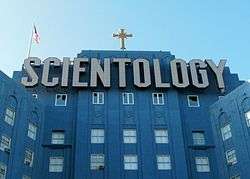
- International Society for Krishna Consciousness(ISKCON) or Hare Krishna movement- founded in 1966 in New York City by A. C. Bhaktivedanta Swami Prabhupada. It preaches Gaudiya Vaishnavism, a sect of Hinduism[140][141]
- New Thought Movement – two of the early proponents of New Thought beliefs during the mid to late 19th century were Phineas Parkhurst Quimby and the Mother of New Thought, Emma Curtis Hopkins. The three major branches are Religious Science, Unity Church and Divine Science.
- Scientology – founded by L. Ron Hubbard in 1954. Numbers estimated from a few tens of thousands to 15 million (latter is the religion's estimation in 2004).
- Reconstructionist Judaism – founded by Mordecai Kaplan and started in the 1920s.
- Native American Church – founded by Quanah Parker beginning in the 1890s and incorporating in 1918. An estimated 250,000 followers.
- Nation of Islam – a sect of Islam, created and followed predominantly by African-Americans.
- Church of Satan – founded in San Francisco in 1966 by Anton LaVey.
- Eckankar – founded in Las Vegas in 1965 by Paul Twitchell.
- Self-Realization Fellowship - founded in Los Angeles by Paramahansa Yogananda in 1920.
- Unitarian Universalist Association- founded in 1961 from the consolidation of the American Unitarian Association and the Universalist Church of America. Historically Christian denominations, the UUA is no longer Christian and is the largest Unitarian Universalist denomination in the world.
Government positions
The First Amendment guarantees both the free practice of religion and the non-establishment of religion by the federal government (later court decisions have extended that prohibition to the states).[142] The U.S. Pledge of Allegiance was modified in 1954 to add the phrase "under God", in order to distinguish itself from the state atheism espoused by the Soviet Union.[143][144][145][146]
Various American presidents have often stated the importance of religion. On February 20, 1955, President Dwight D. Eisenhower stated that "Recognition of the Supreme Being is the first, the most basic, expression of Americanism."[147] President Gerald Ford agreed with and repeated this statement in 1974.[148]
Statistics
The U.S. Census does not ask about religion. Various groups have conducted surveys to determine approximate percentages of those affiliated with each religious group.
2016 Gallup, Inc. data
| Affiliation | % of U.S. population | |
|---|---|---|
| Christian | 73.7 | |
| Protestant/Other Christian | 48.9 | |
| Catholic | 23.0 | |
| Mormon | 1.8 | |
| None/Atheist/Agnostic | 18.2 | |
| Non-Christian faiths | 5.4 | |
| Jewish | 2.1 | |
| Muslim | 0.8 | |
| Other non-Christian religion | 2.5 | |
| No response given | 2.6 | |
| Total | 100 | |
2016 Public Religion Research Institute data
In 2016, a poll by the Public Religion Research Institute estimated that 69% of the Americans are Christians, with 45% professing attendance at a variety of churches that could be considered Protestant, and 20% professing Catholic beliefs. The same study says that other non-Christian religions (including Judaism, Buddhism, Hinduism, and Islam) collectively make up about 7% of the population.[21]
Religion in the United States (2016)[21]
| Affiliation | % of U.S. population | |
|---|---|---|
| Christian | 69 | |
| Protestant | 45 | |
| White Evangelical | 17 | |
| White Mainline Protestant | 13 | |
| Black Protestant | 8 | |
| Hispanic Protestant | 4 | |
| Other non-white Protestant | 3 | |
| Catholic | 20 | |
| White Catholic | 11 | |
| Hispanic Catholic | 7 | |
| Other non-white Catholic | 2 | |
| Mormon | 1 | |
| Jehovah's Witness | 1 | |
| Orthodox Christian | 1 | |
| Unaffiliated | 24 | |
| Non-Christian | 7 | |
| Jewish | 2 | |
| Muslim | 1 | |
| Buddhist | 1 | |
| Hindu | 1 | |
| Other non-Christian | 1 | |
| Don't know/refused answer | 1 | |
| Total | 100 | |
2014 Pew Research Center data
Religion in the United States (2014)[70]
| Affiliation | % of U.S. population | |
|---|---|---|
| Christian | 70.6 | |
| Protestant | 46.5 | |
| Evangelical Protestant | 25.4 | |
| Mainline Protestant | 14.7 | |
| Black church | 6.5 | |
| Catholic | 20.8 | |
| Mormon | 1.6 | |
| Jehovah's Witnesses | 0.8 | |
| Eastern Orthodox | 0.5 | |
| Other Christian | 0.4 | |
| Unaffiliated | 22.8 | |
| Nothing in particular | 15.8 | |
| Agnostic | 4.0 | |
| Atheist | 3.1 | |
| Non-Christian | 5.9 | |
| Jewish | 1.9 | |
| Muslim | 0.9 | |
| Buddhist | 0.7 | |
| Hindu | 0.7 | |
| Other non-Christian | 1.8 | |
| Don't know/refused answer | 0.6 | |
| Total | 100 | |
Regional Data
| Region | Protestant (%) | Catholic (%) | Mormon (%) | Other Christian (%) | Other (%) | Irreligion (%) | Don't know (%) | References |
|---|---|---|---|---|---|---|---|---|
| 78.0 | 7.0 | 1.0 | <1.0 | 1.0 | 12.0 | 1.0 | [149] | |
| 77.0 | 4.0 | 1.0 | <1.0 | 2.0 | 14.0 | 1.0 | [150] | |
| 73.0 | 6.0 | 1.0 | 1.0 | 3.0 | 14.0 | 1.0 | [151] | |
| 70.0 | 8.0 | 1.0 | <1.0 | 3.0 | 18.0 | 1.0 | [152] | |
| 70.0 | 6.0 | 2.0 | <1.0 | 3.0 | 18.0 | 1.0 | [153] | |
| 69.0 | 8.0 | 1.0 | <1.0 | 2.0 | 18.0 | 1.0 | [154] | |
| 67.0 | 9.0 | 1.0 | 2.0 | 3.0 | 18.0 | 1.0 | [155] | |
| 66.0 | 9.0 | 1.0 | 2.0 | 3.0 | 20.0 | 1.0 | [156] | |
| 66.0 | 10.0 | 1.0 | 2.0 | 3.0 | 19.0 | 1.0 | [157] | |
| 65.0 | 10.0 | <1.0 | <1.0 | 2.0 | 22.0 | 1.0 | [158] | |
| 60.0 | 18.0 | <1.0 | <1.0 | 1.0 | 21.0 | 1,0 | [159] | |
| 58.0 | 16.0 | 1.0 | <1.0 | 3.0 | 20.0 | 1.0 | [160] | |
| 58.0 | 12.0 | 2.0 | 1.0 | 6.0 | 20.0 | <1.0 | [161] | |
| 57.0 | 18.0 | 1.0 | 1.0 | 4.0 | 20.0 | <1,0 | [162] | |
| 57.0 | 26.0 | <1.0 | 2.0 | 2.0 | 13.0 | 1.0 | [163] | |
| 57.0 | 22.0 | <1.0 | <1.0 | 3.0 | 18.0 | <1.0 | [164] | |
| 53.0 | 18.0 | 1.0 | 1.0 | 4.0 | 22.0 | <1.0 | [165] | |
| 52.0 | 18.0 | 1.0 | <1.0 | 2.0 | 26.0 | <1.0 | [166] | |
| 52.0 | 15.0 | 1.0 | 2.0 | 8.0 | 23.0 | <1.0 | [167] | |
| 51.0 | 18.0 | <1.0 | 2.0 | 5.0 | 24.0 | 1.0 | [168] | |
| 51.0 | 23.0 | 1.0 | <1.0 | 4.0 | 20.0 | <1,0 | [169] | |
| 51.0 | 26.0 | <1.0 | <1.0 | 3.0 | 20.0 | <1.0 | [170] | |
| 50.0 | 22.0 | 1.0 | <1.0 | 5.0 | 20.0 | 2.0 | [171] | |
| 50.0 | 23.0 | 1.0 | 2.0 | 4.0 | 18.0 | <1.0 | [172] | |
| 47.0 | 24.0 | <1.0 | 1.0 | 6.0 | 21.0 | 1.0 | [173] | |
| 46.5 | 20.8 | 1.6 | 1.7 | 5.9 | 22.8 | 0.6 | [70] | |
| 46.0 | 22.0 | <1.0 | 1.0 | 6.0 | 23.0 | 1.0 | [174] | |
| 46.0 | 21.0 | 1.0 | 2.0 | 6.0 | 24.0 | <1.0 | [175] | |
| 44.0 | 25.0 | <1.0 | 2.0 | 4.0 | 25.0 | <1.0 | [176] | |
| 43.0 | 16.0 | 2.0 | 2.0 | 5.0 | 29.0 | 2.0 | [177] | |
| 43.0 | 28.0 | <1.0 | 2.0 | 6.0 | 22.0 | 1.0 | [178] | |
| 43.0 | 12.0 | 4.0 | 2.0 | 7.0 | 31.0 | 1.0 | [179] | |
| 43.0 | 14.0 | 9.0 | 4.0 | 3.0 | 26.0 | <1.0 | [180] | |
| 42.0 | 17.0 | 4.0 | 2.0 | 5.0 | 30.0 | <1.0 | [181] | |
| 41.0 | 20.0 | 2.0 | 1.0 | 9.0 | 25.0 | 1.0 | [182] | |
| 40.0 | 17.0 | 3.0 | 3.0 | 6.0 | 32.0 | 1.0 | [183] | |
| 39.0 | 21.0 | 5.0 | 1.0 | 6.0 | 27.0 | <1.0 | [184] | |
| 38.0 | 20.0 | 3.0 | 2.0 | 10.0 | 26.0 | 1.0 | [185] | |
| 38.0 | 34.0 | 2.0 | 1.0 | 4.0 | 21.0 | <1.0 | [186] | |
| 37.0 | 16.0 | 5.0 | 5.0 | 6.0 | 31.0 | 1.0 | [187] | |
| 37.0 | 10.0 | 19.0 | 1.0 | 4.0 | 27.0 | <1.0 | [188] | |
| 37.0 | 21.0 | 2.0 | 1.0 | 7.0 | 31.0 | 2.0 | [189] | |
| 35.0 | 33.0 | 1.0 | 2.0 | 7.0 | 23.0 | 1.0 | [190] | |
| 35.0 | 25.0 | 4.0 | 2.0 | 5.0 | 28.0 | 1.0 | [191] | |
| 32.0 | 28.0 | 1.0 | 3.0 | 9.0 | 27.0 | 1.0 | [192] | |
| 31.0 | 34.0 | 1.0 | 2.0 | 14.0 | 18.0 | 1.0 | [193] | |
| 30.0 | 26.0 | 1.0 | 2.0 | 5.0 | 36.0 | <1.0 | [194] | |
| 30.0 | 42.0 | 1.0 | 2.0 | 5.0 | 20.0 | 1.0 | [195] | |
| 30.0 | 22.0 | <1.0 | 1.0 | 8.0 | 37.0 | 2.0 | [196] | |
| 26.0 | 31.0 | <1.0 | 2.0 | 12.0 | 27.0 | 1.0 | [197] | |
| 21.0 | 34.0 | 1.0 | 1.0 | 9.0 | 32.0 | 1.0 | [198] | |
| 13.0 | 5.0 | 55.0 | <1.0 | 4.0 | 22.0 | 1.0 | [199] | |
Metropolitan areas
| Metro area | Christian (%) | Evangelical (%) | Mainline (%) | Historically black (%) | Catholic (%) | Mormon (%) | Non- Christian faiths (%) | None (%) |
|---|---|---|---|---|---|---|---|---|
| 78.0 | 38.0 | 14.0 | 7.0 | 15.0 | 1.0 | 4.0 | 18.0 | |
| 76.0 | 33.0 | 12.0 | 18.0 | 11.0 | 1.0 | 3.0 | 20.0 | |
| 73.0 | 30.0 | 11.0 | 9.0 | 19.0 | 1.0 | 4.0 | 20.0 | |
| 71.0 | 16.0 | 11.0 | 8.0 | 34.0 | <1.0 | 7.0 | 22.0 | |
| Riverside, Calif. | 71.0 | 30.0 | 10.0 | 3.0 | 22.0 | 3.0 | 4.0 | 25.0 |
| 70.0 | 15.0 | 27.0 | 4.0 | 21.0 | 1.0 | 5.0 | 23.0 | |
| San Diego | 68.0 | 14.0 | 16.0 | 2.0 | 32.0 | 2.0 | 5.0 | 27.0 |
| 68.0 | 20.0 | 11.0 | 8.0 | 27.0 | <1.0 | 10.0 | 21.0 | |
| 68.0 | 13.0 | 17.0 | 11.0 | 26.0 | <1.0 | 8.0 | 24.0 | |
| Detroit | 67.0 | 20.0 | 14.0 | 15.0 | 16.0 | <1.0 | 8.0 | 24.0 |
| Phoenix | 66.0 | 25.0 | 11.0 | 1.0 | 21.0 | 6.0 | 7.0 | 26.0 |
| 65.0 | 18.0 | 9.0 | 3.0 | 32.0 | <1.0 | 9.0 | 25.0 | |
| Washington | 65.0 | 14.0 | 15.0 | 12.0 | 19.0 | 1.0 | 10.0 | 24.0 |
| 59.0 | 9.0 | 8.0 | 6.0 | 33.0 | <1.0 | 16.0 | 24.0 | |
| 57.0 | 9.0 | 13.0 | 3.0 | 29.0 | <1.0 | 10.0 | 33.0 | |
| Seattle | 52.0 | 23.0 | 10.0 | 1.0 | 15.0 | 1.0 | 10.0 | 37.0 |
| 48.0 | 10.0 | 6.0 | 4.0 | 25.0 | 1.0 | 15.0 | 35.0 | |
Change in religious identification, 1950-2019 (Gallup)
Percentage of Americans by religious identification (1948–2017)[201]

Protestantism Catholicism Christian (nonspecified) Mormonism Jewish Other None no answer
Attendance
.svg.png)
A 2013 Public Religion Research Institute survey reported that 31% of Americans attend religious services at least weekly.[202]
In a 2009 Gallup International survey, 41.6%[203] of American residents stated that they attended a church, synagogue, or mosque once a week or almost every week. This percentage is higher than other surveyed Western countries.[204][205] Church attendance varies considerably by state and region. The figures, updated to 2014, ranged from 51% in Utah to 17% in Vermont.
When it comes to mosque attendance specifically, data collected by a 2017 poll by the Institute for Social Policy and Understanding (ISPU) shows that American Muslim women and men attend the mosque at similar rates (45% for men and 35% for women).[78] Additionally, when compared to the general public looking at the attendance of religious services, young Muslim Americans attend the mosque at closer rates to older Muslim Americans. Muslim Americans who regularly attend mosques are more likely to work with their neighbors to solve community problems (49 vs. 30 percent), be registered to vote (74 vs. 49 percent), and plan to vote (92 vs. 81 percent). Overall, “there is no correlation between Muslim attitudes toward violence and their frequency of mosque attendance".[78]
| Rank | State | Percent |
|---|---|---|
| 1 | 51% | |
| 2 | 47% | |
| 3 | 46% | |
| 4 | 46% | |
| 5 | 45% | |
| 6 | 42% | |
| 7 | 42% | |
| 8 | 41% | |
| 9 | 40% | |
| 10 | 39% | |
| 11 | 39% | |
| 12 | 39% | |
| 13 | 36% | |
| 14 | 35% | |
| 15 | 35% | |
| 16 | 35% | |
| 17 | 35% | |
| 18 | 35% | |
| 19 | 34% | |
| 20 | 34% | |
| 21 | 33% | |
| 22 | 33% | |
| 23 | 32% | |
| 24 | 32% | |
| 25 | 32% | |
| 26 | 32% | |
| 27 | 32% | |
| 28 | 32% | |
| 29 | 32% | |
| 30 | 31% | |
| 31 | 31% | |
| 32 | 31% | |
| 33 | 30% | |
| 34 | 29% | |
| 35 | 28% | |
| 36 | 28% | |
| 37 | 28% | |
| 38 | 27% | |
| 39 | 27% | |
| 40 | 27% | |
| 41 | 26% | |
| 42 | 25% | |
| 43 | 25% | |
| 44 | 25% | |
| 45 | 24% | |
| 46 | 24% | |
| 47 | 23% | |
| 48 | 22% | |
| 49 | 20% | |
| 50 | 20% | |
| 51 | 17% |
U.S. territories
The following is the percentage of Christians and all religions in the U.S. territories as of 2015:[207][208][209]
| Territory | Percent religious (all religions) | Percent Christian | Percent religious (non-Christian) | Percent non-religious |
|---|---|---|---|---|
| 99.1% | 87.4% | 11.7% | 0.9% | |
| 95.4% | 91.1% | 4.3% | 1.8% | |
| 98.8% | 81.1% | 17.7% | 1.1% | |
| 92.2% | 91.2% | 0.3% | 3.2% | |
| 83.3% | 81.8% | 1.5% | 4% |
2018 ISPU Poll
Highlights
In 2018 The Institute for Social Policy and Understanding published an important study that examined the sentiments of various american faith populations on a variety of issues, focused primarily around ideas of violent extremism, religious pluralism and islamophobia. Their results found that majority of americans, across faith groups, do hold balanced views on Islam and Muslims, and also highlighted the shared sentiments of Muslim and Jewish communities on many of the questions, and the gaps identified between the Evangelical Christians polled and the other members of the study.[210]
| Most Muslims living in the United States... (% Net agree shown) | Muslim | Jewish | Catholic | Protestant | White Evangelical | Non-Affiliated | General Public |
|---|---|---|---|---|---|---|---|
| Are more prone to violence | 18% | 15% | 12% | 13% | 23% | 8% | 13% |
| Discriminate against women | 12% | 23% | 29% | 30% | 36% | 18% | 26% |
| Are hostile to the United States | 12% | 13% | 9% | 14% | 23% | 8% | 12% |
| Are less civilized than other people | 8% | 6% | 4% | 6% | 10% | 1% | 6% |
| Are partially responsible for acts of violence carried out by other Muslims | 10% | 16% | 11% | 12% | 14% | 8% | 12% |
| Index (0 min - 100 max) | 17 | 22 | 22 | 31 | 40 | 14 | 24 |
| My faith identity/ community... (% Net agree shown) | Muslim | Jewish | Catholic | Protestant | White Evangelical | Non-Affiliated | General Public |
|---|---|---|---|---|---|---|---|
| Is a source of happiness | 85% | 72% | 73% | 81% | 94% | 34% | 68% |
| Contributes to society | 85% | 91% | 78% | 79% | 95% | 44% | 71% |
| Makes me proud | 86% | 87% | 85% | 83% | 95% | 37% | 72% |
| Index | 87 | 86 | 82 | 85 | 93 | 58 | 78 |
The following graph shows data across six different faith populations in the United States, and their answers to the two questions below. (Note: "W. Evang." is short for White Evangelical, the specific demographic surveyed.):
Question 1: Some people think that for the military to target and kill civilians is sometimes justified, while others think that this kind of violence is never justified. Which is your opinion?
Question 2: Some people think that for an individual or a small group of people to target and kill civilians is sometimes justified, while others think that this kind of violence is never justified. Which is your opinion?
- Question 1 (% Never Justified)
- Question 2 (% Never Justified)
The following graph contains additional data collected by ISPU during their 2018 poll. The following statements were posed to participants and they were asked to answer on a scale from strongly agree to strongly disagree. The chart below shows the total percentage from each American faith demographic that agreed with the statements below. (Note: "W. Evang." is short for White Evangelical, the specific demographic surveyed.)
Question 1: I want to live in a country where no one is targeted for their religious idenitity
Question 2: The negative things politicians say regarding Muslims is harmful to our country
Question 3: Most Muslims living in the United States are committed to the wellbeing of America
Question 4: Most people associate negative stereotypes with my faith identity
- Question 1 (% Net agree)
- Question 2 (% Net agree)
- Question 3 (% Net Agree)
- Question 4 (% Net agree)
Religion and politics
In August 2010, 67% of Americans said religion was losing influence, compared with 59% who said this in 2006. Majorities of white evangelical Protestants (79%), white mainline Protestants (67%), black Protestants (56%), Catholics (71%), and the religiously unaffiliated (62%) all agreed that religion was losing influence on American life; 53% of the total public said this was a bad thing, while just 10% see it as a good thing.[211]
Politicians frequently discuss their religion when campaigning, and fundamentalists and black Protestants are highly politically active. However, to keep their status as tax-exempt organizations they must not officially endorse a candidate. Historically Catholics were heavily Democratic before the 1970s, while mainline Protestants comprised the core of the Republican Party. Those patterns have faded away—Catholics, for example, now split about 50–50. However, white evangelicals since 1980 have made up a solidly Republican group that favors conservative candidates. Secular voters are increasingly Democratic.[212]
Only four presidential candidates for major parties have been Catholics, all for the Democratic party:
- Alfred E. Smith in presidential election of 1928 was subjected to anti-Catholic rhetoric, which seriously hurt him in the Baptist areas of the South and Lutheran areas of the Midwest, but he did well in the Catholic urban strongholds of the Northeast.
- John F. Kennedy secured the Democratic presidential nomination in 1960. In the 1960 election, Kennedy faced accusations that as a Catholic president he would do as the Pope would tell him to do, a charge that Kennedy refuted in a famous address to Protestant ministers.
- John Kerry, a Catholic, won the Democratic presidential nomination in 2004. In the 2004 election religion was hardly an issue, and most Catholics voted for his Protestant opponent George W. Bush.[213]
- Joe Biden, a Catholic, is currently the presumptive nominee for the Democratic presidential nomination for the 2020 presidential election, Biden was also the first Catholic vice president.[214]
Joe Lieberman was the first major presidential candidate that was Jewish, on the Gore–Lieberman campaign of 2000 (although John Kerry and Barry Goldwater both had Jewish ancestry, they were practicing Christians). Bernie Sanders ran against Hillary Clinton in the Democratic primary of 2016. He was the first major Jewish candidate to compete in the presidential primary process. However, Sanders noted during the campaign that he does not actively practice any religion.[215]
In 2006 Keith Ellison of Minnesota became the first Muslim elected to Congress; when re-enacting his swearing-in for photos, he used the copy of the Qur'an once owned by Thomas Jefferson.[216] André Carson is the second Muslim to serve in Congress.
A Gallup poll released in 2007[217] indicated that 53% of Americans would refuse to vote for an atheist as president, up from 48% in 1987 and 1999. But then the number started to drop again and reached record low 43% in 2012 and 40% in 2015.[218][219]
Mitt Romney, the Republican presidential nominee in 2012, is Mormon and a member of The Church of Jesus Christ of Latter-day Saints. He is the former governor of the state of Massachusetts, and his father George Romney was the governor of the state of Michigan. The Romneys were involved in Mormonism in their states and in the state of Utah.
On January 3, 2013, Tulsi Gabbard became the first Hindu member of Congress, using a copy of the Bhagavad Gita while swearing-in.[220]
2010 ARDA data
The Association of Religion Data Archives (ARDA) surveyed congregations for their memberships. Churches were asked for their membership numbers. Adjustments were made for those congregations that did not respond and for religious groups that reported only adult membership.[221] ARDA estimates that most of the churches not responding were black Protestant congregations. Significant difference in results from other databases include the lower representation of adherents of 1) all kinds (62.7%), 2) Christians (59.9%), 3) Protestants (less than 36%); and the greater number of unaffiliated (37.3%).

| Major | >10% | >20% | |
| Catholic | |||
| Baptist | |||
| Lutheran | |||
| Methodist | |||
| No religion | |||
| Mormonism | |||
| Protestant | |||
| Pentecostal | |||
| Christian (unspecified/other) |

| Religious group | Number in year 2010 | % in year 2010 |
|---|---|---|
| Total US pop year 2010 | 308,745,538 | 100.0% |
| Evangelical Protestant | 50,013,107 | 16.2% |
| Mainline Protestant | 22,568,258 | 7.3% |
| Black Protestant | 4,877,067 | 1.6% |
| Protestant total | 77,458,432 | 25.1% |
| Catholic | 58,934,906 | 19.1% |
| Orthodox | 1,056,535 | 0.3% |
| adherents (unadjusted) | 150,596,792 | 48.8% |
| unclaimed | 158,148,746 | 51.2% |
| other – including Mormon & Christ Scientist | 13,146,919 | 4.3% |
| The Church of Jesus Christ of Latter Day Saints (Mormon, LDS) | 6,144,582 | 2.0% |
| other – excluding Mormon | 7,002,337 | 2.3% |
| Jewish estimate | 6,141,325 | 2.0% |
| Buddhist estimate | 2,000,000 | 0.7% |
| Muslim estimate | 2,600,082 | 0.8% |
| Hindu estimate | 400,000 | 0.4% |
| Source: ARDA[75][222] | ||
ARIS findings regarding self-identification
The United States government does not collect religious data in its census. The survey below, the American Religious Identification Survey (ARIS) of 2008, was a random digit-dialed telephone survey of 54,461 American residential households in the contiguous United States. The 1990 sample size was 113,723; 2001 sample size was 50,281.
Adult respondents were asked the open-ended question, "What is your religion, if any?" Interviewers did not prompt or offer a suggested list of potential answers. The religion of the spouse or partner was also asked. If the initial answer was "Protestant" or "Christian" further questions were asked to probe which particular denomination. About one third of the sample was asked more detailed demographic questions.
Religious Self-Identification of the U.S. Adult Population: 1990, 2001, 2008[59]
Figures are not adjusted for refusals to reply; investigators suspect refusals are possibly more representative of "no religion" than any other group.
| Group | 1990 adults x 1,000 | 2001 adults x 1,000 | 2008 adults x 1,000 | Numerical Change 1990– 2008 as % of 1990 | 1990 % of adults | 2001 % of adults | 2008 % of adults | change in % of total adults 1990– 2008 |
|---|---|---|---|---|---|---|---|---|
| Adult population, total | 175,440 | 207,983 | 228,182 | 30.1% | ||||
| Adult population, responded | 171,409 | 196,683 | 216,367 | 26.2% | 97.7% | 94.6% | 94.8% | −2.9% |
| Total Christian | 151,225 | 159,514 | 173,402 | 14.7% | 86.2% | 76.7% | 76.0% | −10.2% |
| Catholic | 46,004 | 50,873 | 57,199 | 24.3% | 26.2% | 24.5% | 25.1% | −1.2% |
| non-Catholic Christian | 105,221 | 108,641 | 116,203 | 10.4% | 60.0% | 52.2% | 50.9% | −9.0% |
| Baptist | 33,964 | 33,820 | 36,148 | 6.4% | 19.4% | 16.3% | 15.8% | −3.5% |
| Mainline Christian | 32,784 | 35,788 | 29,375 | −10.4% | 18.7% | 17.2% | 12.9% | −5.8% |
| Methodist | 14,174 | 14,039 | 11,366 | −19.8% | 8.1% | 6.8% | 5.0% | −3.1% |
| Lutheran | 9,110 | 9,580 | 8,674 | −4.8% | 5.2% | 4.6% | 3.8% | −1.4% |
| Presbyterian | 4,985 | 5,596 | 4,723 | −5.3% | 2.8% | 2.7% | 2.1% | −0.8% |
| Episcopal/Anglican | 3,043 | 3,451 | 2,405 | −21.0% | 1.7% | 1.7% | 1.1% | −0.7% |
| United Church of Christ | 438 | 1,378 | 736 | 68.0% | 0.2% | 0.7% | 0.3% | 0.1% |
| Christian Generic | 25,980 | 22,546 | 32,441 | 24.9% | 14.8% | 10.8% | 14.2% | −0.6% |
| Christian Unspecified | 8,073 | 14,190 | 16,384 | 102.9% | 4.6% | 6.8% | 7.2% | 2.6% |
| Non-denominational Christian | 194 | 2,489 | 8,032 | 4040.2% | 0.1% | 1.2% | 3.5% | 3.4% |
| Protestant – Unspecified | 17,214 | 4,647 | 5,187 | −69.9% | 9.8% | 2.2% | 2.3% | −7.5% |
| Evangelical/Born Again | 546 | 1,088 | 2,154 | 294.5% | 0.3% | 0.5% | 0.9% | 0.6% |
| Pentecostal/Charismatic | 5,647 | 7,831 | 7,948 | 40.7% | 3.2% | 3.8% | 3.5% | 0.3% |
| Pentecostal – Unspecified | 3,116 | 4,407 | 5,416 | 73.8% | 1.8% | 2.1% | 2.4% | 0.6% |
| Assemblies of God | 617 | 1,105 | 810 | 31.3% | 0.4% | 0.5% | 0.4% | 0.0% |
| Church of God | 590 | 943 | 663 | 12.4% | 0.3% | 0.5% | 0.3% | 0.0% |
| Other Protestant Denominations | 4,630 | 5,949 | 7,131 | 54.0% | 2.6% | 2.9% | 3.1% | 0.5% |
| Churches of Christ | 1,769 | 2,593 | 1,921 | 8.6% | 1.0% | 1.2% | 0.8% | −0.2% |
| Jehovah's Witness | 1,381 | 1,331 | 1,914 | 38.6% | 0.8% | 0.6% | 0.8% | 0.1% |
| Seventh-Day Adventist | 668 | 724 | 938 | 40.4% | 0.4% | 0.3% | 0.4% | 0.0% |
| Mormon/Latter Day Saints | 2,487 | 2,697 | 3,158 | 27.0% | 1.4% | 1.3% | 1.4% | 0.0% |
| Total non-Christian religions | 5,853 | 7,740 | 8,796 | 50.3% | 3.3% | 3.7% | 3.9% | 0.5% |
| Jewish | 3,137 | 2,837 | 2,680 | −14.6% | 1.8% | 1.4% | 1.2% | −0.6% |
| Eastern Religions | 687 | 2,020 | 1,961 | 185.4% | 0.4% | 1.0% | 0.9% | 0.5% |
| Buddhist | 404 | 1,082 | 1,189 | 194.3% | 0.2% | 0.5% | 0.5% | 0.3% |
| Muslim | 527 | 1,104 | 1,349 | 156.0% | 0.3% | 0.5% | 0.6% | 0.3% |
| New Religious Movements & Others | 1,296 | 1,770 | 2,804 | 116.4% | 0.7% | 0.9% | 1.2% | 0.5% |
| None/No religion, total | 14,331 | 29,481 | 34,169 | 138.4% | 8.2% | 14.2% | 15.0% | 6.8% |
| Agnostic+Atheist | 1,186 | 1,893 | 3,606 | 204.0% | 0.7% | 0.9% | 1.6% | 0.9% |
| Did Not Know/Refused to reply | 4,031 | 11,300 | 11,815 | 193.1% | 2.3% | 5.4% | 5.2% | 2.9% |
Highlights:[59]
- The ARIS 2008 survey was carried out during February–November 2008 and collected answers from 54,461 respondents who were questioned in English or Spanish.
- The American population self-identifies as predominantly Christian, but Americans are slowly becoming less Christian.
- 86% of American adults identified as Christians in 1990 and 76% in 2008.
- The historic mainline churches and denominations have experienced the steepest declines, while the non-denominational Christian identity has been trending upward, particularly since 2001.
- The challenge to Christianity in the U.S. does not come from other religions but rather from a rejection of all forms of organized religion.
- 34% of American adults considered themselves "Born Again or Evangelical Christians" in 2008.
- The U.S. population continues to show signs of becoming less religious, with one out of every seven Americans failing to indicate a religious identity in 2008.
- The "Nones" (no stated religious preference, atheist, or agnostic) continue to grow, though at a much slower pace than in the 1990s, from 8.2% in 1990, to 14.1% in 2001, to 15.0% in 2008.
- Asian Americans are substantially more likely to indicate no religious identity than other racial or ethnic groups.
- One sign of the lack of attachment of Americans to religion is that 27% do not expect a religious funeral at their death.
- Based on their stated beliefs rather than their religious identification in 2008, 70% of Americans believe in a personal God, roughly 12% of Americans are atheist (no God) or agnostic (unknowable or unsure), and another 12% are deistic (a higher power but no personal God).
- America's religious geography has been transformed since 1990. Religious switching along with Hispanic immigration has significantly changed the religious profile of some states and regions. Between 1990 and 2008, the Catholic population proportion of the New England states fell from 50% to 36% and in New York fell from 44% to 37%, while it rose in California from 29% to 37% and in Texas from 23% to 32%.
- Overall the 1990–2008 ARIS time series shows that changes in religious self-identification in the first decade of the 21st century have been moderate in comparison to the 1990s, which was a period of significant shifts in the religious composition of the United States.
Ethnicity
The table below shows the religious affiliations among the ethnicities in the United States, according to the Pew Forum 2014 survey.[70] People of Black ethnicity were most likely to be part of a formal religion, with 80% percent being Christians. Protestant denominations make up the majority of the Christians in the ethnicities.
| Religion | Non-Hispanic White |
Black | Hispanic | Other/mixed |
|---|---|---|---|---|
| Christian | 70% | 79% | 77% | 49% |
| Protestant | 48% | 71% | 26% | 33% |
| Catholic | 19% | 5% | 48% | 13% |
| Mormon | 2% | <0.5% | 1% | 1% |
| Jehovah's Witness | <0.5% | 2% | 1% | 1% |
| Orthodox | 1% | <0.5% | <0.5% | 1% |
| Other | <0.5% | 1% | <0.5% | 1% |
| Non-Christian faiths | 5% | 3% | 2% | 21% |
| Jewish | 3% | <0.5% | 1% | 1% |
| Muslim | <0.5% | 2% | <0.5% | 3% |
| Buddhist | <0.5% | <0.5% | 1% | 4% |
| Hindu | <0.5% | <0.5% | <0.5% | 8% |
| Other world religions | <0.5% | <0.5% | <0.5% | 2% |
| Other faiths | 2% | 1% | 1% | 2% |
| Unaffiliated (including atheist and agnostic) | 24% | 18% | 20% | 29% |
See also
- American civil religion
- Christianity in the United States
- Confucianism in the United States
- Freedom of religion in the United States
- Historical religious demographics of the United States
- List of religious movements that began in the United States
- List of U.S. states and territories by religiosity
- Relationship between religion and science
- Religion in United States prisons
- School prayer in the United States
- Separation of church and state in the United States
References
- "In U.S., Decline of Christianity Continues at Rapid Pace", Pew Research Center, October 17, 2019, Retrieved July 27, 2020.
- "Americans are far more religious than adults in other wealthy nations". Pew Research Center. July 31, 2018. Retrieved January 23, 2020.
- Newport, Frank (February 4, 2016). "New Hampshire Now Least Religious State in U.S." Gallup. Retrieved August 3, 2016.
- "Australia - Oceania :: American Samoa — The World Factbook - Central Intelligence Agency". www.cia.gov.
- Sydney Ahlstrom, A Religious History of the American People (Yale UP, 2nd ed. 2004) ISBN 0-300-10012-4
- Kevin M. Schultz, and Paul Harvey, "Everywhere and Nowhere: Recent Trends in American Religious History and Historiography", Journal of the American Academy of Religion, March 2010, Vol. 78 Issue 1, pp. 129–162
- See: English Civil War, Glorious Revolution, Restoration (England) and Nonconformists
- David E. Swift (1989). Black Prophets of Justice: Activist Clergy Before the Civil War. LSU Press. p. 180. ISBN 9780807124994.
- The treaty is online
- Tri-Faith America: How Catholics and Jews Held Postwar America to Its Protestant Promise by Kevin M. Schultz, p. 9
- Obligations of Citizenship and Demands of Faith: Religious Accommodation in Pluralist Democracies by Nancy L. Rosenblum, Princeton University Press, 2000 – 438, p. 156
- The Protestant Voice in American Pluralism by Martin E. Marty, chapter 1
- "10 facts about religion in America". pewresearch.org. August 27, 2015. Retrieved August 27, 2017.
- Barnstone, Aliki; Manson, Michael Tomasek; Singley, Carol J. (August 27, 1997). The Calvinist Roots of the Modern Era. UPNE. ISBN 9780874518085. Retrieved August 27, 2017 – via Google Books.
- Holmes, David L. (May 1, 2006). The Faiths of the Founding Fathers. Oxford University Press, USA. p. 13. ISBN 9780195300925. Retrieved August 27, 2017 – via Internet Archive.
united states founded on calvinism.
- "Calvinism: The Spiritual Foundation of America". Geopolitica.ru. January 20, 2016. Retrieved September 18, 2017.
- 36 U.S.C. § 302 National motto
- "U.S. on the History of "In God We Trust"". United States Department of the Treasury. Retrieved April 22, 2009.
- United States Public Law 84-851, United States Public Law 84-851.
- Gilleland, Don (January 3, 2013). "50 years of change". Florida Today. Melbourne, Florida. pp. 9A.
- Cox, Daniel; Jones, Ribert P. (June 9, 2017). America's Changing Religious Identity. 2016 American Values Atlas. Public Religion Research Institute.
- Encylclopedia Britannica, https://www.britannica.com/place/Massachusetts-Bay-Colony
- Feldman, Noah (2005). Divided by God. Farrar, Straus and Giroux, p. 10 ("For the first time in recorded history, they designed a government with no established religion at all.")
- Marsden, George M. 1990. Religion and American Culture. Orlando: Harcourt Brace Jovanovich, pp. 45–46.
- Newport, Frank (December 23, 2016). "Five Key Findings on Religion in the U.S." Gallup. Retrieved April 5, 2018.
- "Religion Census Newsletter" (PDF). RCMS2010.org. Association of Statisticians of American Religious Bodies. March 2017. Retrieved March 17, 2017.
- "News from the National Council of Churches". Ncccusa.org.
- Gaustad 1962
- "Annual of the 2007 Southern Baptist Convention" (PDF). Retrieved December 29, 2012.
- The figures for this 2007 abstract are based on surveies for 1990 and 2001 from the Graduate School and University Center at the City University of New York. Kosmin, Barry A.; Egon Mayer; Ariela Keysar (2001). "American Religious Identification Survey" (PDF). City University of New York.; Graduate School and University Center. Archived from the original (PDF) on June 14, 2007. Retrieved April 4, 2007.
- Johnstone, Patrick; Miller, Duane (2015). "Believers in Christ from a Muslim Background: A Global Census". IJRR. 11: 14. Retrieved November 20, 2015.
- "Why Are Millions of Muslims Becoming Christian?". National Catholic Register.
- McKinney, William. "Mainline Protestantism 2000." Annals of the American Academy of Political and Social Science, Vol. 558, Americans and Religions in the Twenty-First Century (July, 1998), pp. 57-66.
- Harriet Zuckerman, Scientific Elite: Nobel Laureates in the United States New York, The Free Pres, 1977, p.68: Protestants turn up among the American-reared laureates in slightly greater proportion to their numbers in the general population. Thus 72 percent of the seventy-one laureates but about two thirds of the American population were reared in one or another Protestant denomination-)
- B. Drummond Ayres, Jr. (December 19, 2011). "The Episcopalians: An American Elite with Roots Going Back to Jamestown". New York Times. Retrieved August 17, 2012.
- Hacker, Andrew (1957). "Liberal Democracy and Social Control". American Political Science Review. 51 (4): 1009–1026 [p. 1011]. doi:10.2307/1952449. JSTOR 1952449.
- Ron Chernow, Titan (New York: Random, 1998) 50.
- Irving Lewis Allen, "WASP—From Sociological Concept to Epithet," Ethnicity, 1975 154+
- "America's Changing Religious Landscape". Pew Research Center. May 12, 2015.
- http://www.pewforum.org See: "How income varies among US religious groups." 19% of Catholics (19% of 75 million, i.e., over 14 million) "live in households with incomes of at least 100,000."
- "The Harvard Guide: The Early History of Harvard University". News.harvard.edu. Archived from the original on July 22, 2010. Retrieved August 29, 2010.
- "Increase Mather"., Encyclopædia Britannica Eleventh Edition, Encyclopædia Britannica
- Princeton University Office of Communications. "Princeton in the American Revolution". Retrieved May 24, 2011. The original Trustees of Princeton University "were acting in behalf of the evangelical or New Light wing of the Presbyterian Church, but the college had no legal or constitutional identification with that denomination. Its doors were to be open to all students, 'any different sentiments in religion notwithstanding.'"
- McCaughey, Robert (2003). Stand, Columbia: A History of Columbia University in the City of New York. New York, New York: Columbia University Press. p. 1. ISBN 0231130082.
- Childs, Francis Lane (December 1957). "A Dartmouth History Lesson for Freshman". Dartmouth Alumni Magazine. Retrieved February 12, 2007.
- W.L. Kingsley et al., "The College and the Church," New Englander and Yale Review 11 (Feb 1858): 600. accessed 2010-6-16 Note: Middlebury is considered the first "operating" college in Vermont as it was the first to hold classes in Nov 1800. It issued the first Vermont degree in 1802; UVM followed in 1804.
- James Davison Hunter (March 31, 2010). To Change the World: The Irony, Tragedy, and Possibility of Christianity in the Late Modern World. Oxford UP. p. 85. ISBN 9780199779529.
- Archaeology, Narrative, and the Politics of the Past: The View from Southern Maryland, p. 52, UPCC book collections on Project MUSE, Julia A. King, Publisher, Univ. of Tennessee Press, 2012, ISBN 9781572338883
- Richard Middleton, Colonial America: a History, 1565-1776 (Oxford: Blackwell, 2002) 94-101.
- Alan Taylor, American Colonies, (New York: Viking, 2001) 76-90.
- Taylor, 454-456; 364-395.
- Taylor, 458-459; 365-366, 368.
- US News and World Report, College Rankings, 2020.
- Sydney E. Ahlstrom, A religious history of the American people (1976) pp. 121-59 .
- FitzGerald 2007, p. 269-279.
- Alexei D. Krindatch, ed., Atlas of American Orthodox Christian Churches (Holy Cross Orthodox Press, 2011) online.
- "Largest Latter-day Saint Communities (Mormon/Church of Jesus Christ Statistics)". adherents.com. April 12, 2005.
- "American Religious Identification Survey". Exhibit 15. The Graduate Center, City University of New York. Retrieved November 24, 2006.
- Barry A. Kosmin and Ariela Keysar (2009). "American Religious Identification Survey (ARIS) 2008" (PDF). Hartford, Connecticut, US: Trinity College. Retrieved April 1, 2009.
- "Barna Survey Examines Changes in Worldview Among Christians over the Past 13 Years". The Barna Group. March 6, 2009. Archived from the original on March 12, 2009. Retrieved June 26, 2009.
- "America's Changing Religious Landscape". Pew Research Center: Religion & Public Life. May 12, 2015.
- US Religious Landscape Survey: Diverse and Dynamic (PDF), The Pew Forum, February 2008, p. 85, retrieved September 17, 2012
- "The most and least educated U.S. religious group". Pew Research Center. October 16, 2016.
- Leonhardt, David (May 13, 2011). "Faith, Education and Income". The New York Times. Retrieved May 13, 2011.
- "How income varies among U.S. religious groups". Pew Research Center. October 16, 2016.
- "The most and least educated U.S. religious groups," and "how income varies among U.S. religious groups" in Pew Research Center: 26% and 19% of 75 million Catholics are college graduates and high income earners, respectively. No religious community can match those numbers
- Taylor, Humphrey (October 15, 2003), "While Most Americans Believe in God, Only 36% Attend a Religious Service Once a Month or More Often" (PDF), The Harris Poll #59, HarrisInteractive.com, Harris Interactive, retrieved February 18, 2014
- Kosmin, Mayer & Keysar (December 19, 2001). "American Identification Survey, 2001" (PDF). The Graduate Center of the City University of New York New York. pp. 8–9. Retrieved November 24, 2012.
- "Jewish Community Study of New York" (PDF). United Jewish Appeal-Federation of New York. 2002. Archived from the original (PDF) on June 14, 2007. Retrieved March 22, 2008.
- "America's Changing Religious Landscape". Pew Research Center: Religion & Public Life. May 12, 2015.
- "CIA Fact Book". CIA World Fact Book. 2002. Retrieved December 30, 2007.
- Jack Wertheimer (2002). Jews in the Center: Conservative Synagogues and Their Members. Rutgers University Press. p. 68. ISBN 9780813532066.
- Adele Reinhartz (2014). "The Vanishing Jews of Antiquity". Los Angeles Review of Books.
- Ira M. Sheskin and Arnold Dashefsky, University of Miami and University of Connecticut (2009). "Jewish Population of the United States, 2009" (PDF). Mandell L. Berman North American Jewish Data Bank in cooperation with the Association for the Social Scientific Study of Jewry and the Jewish Federations of North America. Archived from the original (PDF) on September 12, 2012. The authors concluded the 6,543,820 figure was an over-count, due to people who live in more than one state during a year.
- "The Association of Religion Data Archives (ARDA), Year 2000 Report". ARDA. 2000. Archived from the original on March 21, 2008. Retrieved June 4, 2011. Churches were asked for their membership numbers. ARDA estimates that most of the churches not reporting were black Protestant congregations.
- "2001 National Jewish Population Survey". Ujc.org. Archived from the original on May 15, 2004. Retrieved December 29, 2012.
- Institute for Social Policy and Understanding (July 2018). "Impact Report of Muslim Contributions to New York City". Muslims for American Progress.
- "American Muslim Poll 2017 | ISPU". Institute for Social Policy and Understanding. March 21, 2017. Retrieved December 5, 2018.
- Tweed, Thomas A. "Islam in America: From African Slaves to Malcolm X". National Humanities Center. Retrieved July 21, 2009.
- Kambiz GhaneaBassiri, A History of Islam in America: From the New World to the New World Order (Cambridge University Press, 2010) pp. 59–94
- Timothy Miller (1995). America's alternative religions. State University of New York Press. p. 280. ISBN 9780791423974.
Ahmadiyya.
- Mattias Gardell, In the Name of Elijah Muhammad: Louis Farrakhan and The Nation of Islam (Duke University Press, 1996)
- C. Eric Lincoln, The Black Muslims in America (3rd ed. Eerdmans, 1994)
- "First Muslim Elected to Congress". Cbsnews.com. February 11, 2009. Retrieved December 29, 2012.
- Cebula, Judith (March 11, 2008). "Second Muslim elected to Congress". Reuters.com. Retrieved December 29, 2012.
- "Zogby phone survey" (PDF). Projectmaps.com. Archived from the original (PDF) on June 26, 2013. Retrieved March 17, 2012.
- "America's Muslims after 9/11". Voice of America. Archived from the original on July 17, 2011. Retrieved May 22, 2010.
- "Muslim Americans, Pew Research Center" (PDF). Archived from the original (PDF) on September 16, 2012. Retrieved December 29, 2012.
- Melton, Encyclopedia of American Religions (2003) pp. 992–995
- "Rastafarian history". BBC.co.uk. Retrieved May 29, 2015.
- Loadenthal, Michael. "Jah People: The cultural hybridity of white Rastafarians". GlocalismJournal.net. Retrieved May 29, 2015.
- "Rastafarianism". Religionfacts.com. Retrieved May 29, 2015.
- "Rastari History". Religionfacts.com. Retrieved May 29, 2015.
- "Bad Buddhist Vibes". Utne. Retrieved March 5, 2015.
- The Faces of Buddhism in America. University of California Press. Retrieved March 5, 2015.
- Kosmin, Mayer & Keysar (December 19, 2001). "American Identification Survey, 2001" (PDF). The Graduate Center of the City University of New York New York. p. 13. Retrieved November 24, 2012.
- "Religious Composition of the U.S." (PDF). U.S Religious Landscape Survey. Pew Forum on Religion & Public Life. February 2008. Retrieved August 8, 2012.
- "Pewforum religious landscape study". Retrieved February 20, 2020.
- "About JAINA". Retrieved January 16, 2012.
- The Pioneers, America, "A historical perspective of Americans of Asian Indian origin 1790–1997" October 31, 2006
- Stockton Gurdwara, America, "Stockton California" Archived May 7, 2008, at the Wayback Machine October 31, 2006
- Mann, Gurinder Singh; Numrich, Paul; Williams, Raymond (December 3, 2007). Buddhists, Hindus and Sikhs in America: A Short History, p. 120. ISBN 9780198044246. Retrieved August 10, 2012.
- The Racialization of Hinduism, Islam, and Sikhism in the United States, Khyati Y. Joshi, 2006.
- Ronald H. Bayor (July 31, 2011). Multicultural America: An Encyclopedia of the Newest Americans. ABC-CLIO. pp. 985–. ISBN 978-0-313-35787-9. Retrieved June 6, 2013.
- "largest religious groups in the US". Adherents.com. Archived from the original on August 20, 2018. Retrieved December 29, 2012.
- "Taoism at a glance". Bbc.co.uk. January 1, 1970. Retrieved December 29, 2012.
- Phillips, Erica E.; Kesling, Ben (March 9–10, 2013). "Some Church Folk Ask: 'What Would Jesus Brew?'". The Wall Street Journal (paper).
- "Atheists Are Distrusted". May 3, 2006. Archived from the original on June 13, 2010. Retrieved February 16, 2010.
- Paulos, John Allen (April 2, 2006). "Who's Counting: Distrusting Atheists". ABC News. Retrieved February 16, 2010.
- "Atheists identified as America's most distrusted minority, according to new U of M study". UMN News. Retrieved March 22, 2006.
- "Pew survey: Doubt of God growing quickly among millennials". Religion.blogs.cnn.com. August 16, 2012. Retrieved December 29, 2012.
- Raushenbush, Paul (March 24, 2012). "Atheists Rally on National Mall". Huffingtonpost.com. Retrieved December 29, 2012.
- "Excerpts from Allen's Reason The Only Oracle Of Man". Ethan Allen Homestead Museum. Archived from the original on May 2, 2008.
- "Religious Landscape Study - Pew Research Center". May 11, 2015. Retrieved July 4, 2016.
- "Religiosity and Atheism" (PDF). Archived from the original (PDF) on September 6, 2012. Retrieved December 29, 2012.
- Merica, Dan (June 12, 2012). "Pew Survey: Doubt of God Growing Quickly among Millennials". CNN. Retrieved June 14, 2012.
- "More Than 9 in 10 Americans Continue to Believe in God". Gallup.com. June 3, 2011. Retrieved December 29, 2012.
- "What People Do and Do Not Believe in" (PDF). Harris Interactive. December 15, 2009. Archived from the original (PDF) on January 24, 2011. Retrieved May 15, 2011.
- Eric Ferreri (August 16, 2011). "according to Mark Chaves". Today.duke.edu. Retrieved December 29, 2012.
- Newport, Frank (July 28, 2008). "Belief in God Far Lower in Western U.S." The Gallup Organization. Retrieved September 4, 2010.
- Heelas, Spiritualities of Life, 63.
- Heelas, Spiritualities of Life, 64.
- Carette and King, Selling Spirituality, 41.
- Funk, Cary; Smith, Greg. ""Nones" on the Rise: One-in-Five Adults Have No Religious Affiliation" (PDF). pewforum.org. The Pew Forum on Religion and Public Life. Archived from the original (PDF) on June 29, 2014. Retrieved December 6, 2015.
- Utter, Jack. American Indians: Answers to Today's Questions. 2nd edition. University of Oklahoma Press, 2001, p. 145.
- Or about .003% of the U.S. population of 300 million. James T. Richardson (2004). Regulating Religion: Case Studies from Around the Globe. Springer. p. 543. ISBN 9780306478864.
- Barbara Jane Davy, Introduction to Pagan Studies, p. 151 (2007)
- Rosemary Guiley, The Encyclopedia of Magic and Alchemy, p. 84 (2006)
- Trinity ARIS 2008; Trinity ARIS 2001 Archived June 25, 2010, at the Wayback Machine
- Adler 2006. pp. 337–339.
- Raymond Buckland, Scottish Witchcraft: The history & magick of the Picts, p. 246 (1991)
- "Siver Chalice Ancestry". www.angelfire.com.
- William James, "The Varieties of Religious Experience". pp. 92–93. New York 1929
- "Unitarian Universalists Denounce White Supremacy, Make Leadership Changes". NPR.org.
- "Unitarian Universalism's Seven Principles". UUA.org. November 24, 2014.
- (The 4th principle of Unitarian Universalism) UUA.org Seven principles
- "Unitarian Universalist Origins: Our Historic Faith". UUA.org. February 8, 2013.
- "Archived copy". Archived from the original on October 6, 2017. Retrieved October 5, 2017.CS1 maint: archived copy as title (link)
- Global Christianity (PDF). Pew Research Center. 2011. Archived from the original (PDF) on August 5, 2013. Retrieved January 14, 2015.
- Gibson 2002, p. 4
- Gibson 2002, p. 6
- Everson v. Board of Education
- Thomas Berg (March 10, 2004). "The Pledge of Allegiance and the Limited State". Texas Review of Law and Politics, Vol. 8, Fall 2003. SSRN 503622.
The inclusion of "under God" in the Pledge, the report says, "would serve to deny the atheistic and materialistic conceptions of communism with its attendant subservience of the individual".
- Scott A. Merriman (2007). Religion and the Law in America: An Encyclopedia of Personal Belief and Public Policy. ABC-CLIO. ISBN 9781851098637. Retrieved October 18, 2007.
The United States, wanting to distinguish itself from the USSR and its atheist positions, went to great extremes to demonstrate that God was still supreme in this country.
- Natalie Goldstein, Walton Brown-Foster (2010). Religion and the State. Infobase Publishing. ISBN 9781438131245. Retrieved October 18, 2007.
In the early 1950s, a Presbyterian minister in New York gave a sermon in which he railed against the U.S. Pledge of Allegiance because it contained no references to God. According to the reverend, the American pledge could serve just as well in the atheistic Soviet Union; there was nothing in the U.S. pledge to distinguish it from an oath to the godless communist state. So in 1954, Congress passed a law that inserted the phrase "under God" into the Pledge of Allegiance.
- Ann W. Duncan, Steven L. Jones (2008). Church-State Issues in America Today: Volume 2, Religion, Family, and Education. Præger. ISBN 9780275993696. Retrieved October 18, 2007.
Including God in the nation's pledge would send a clear message to the world that unlike communist regimes that denied God's existence, the United States recognized a Supreme Being. Official acknowledgement of God would further distinguish freedom-loving Americans from their atheist adversaries.
- John Micklethwait, Adrian Wooldridge (April 2, 2009). God Is Back: How the Global Revival of Faith Is Changing the World. Penguin Books. ISBN 9781101032411. Retrieved October 18, 2007.
Recognition of the Supreme Being is the first, the most basic, expression of Americanism," he declared in a speech launching the American Legion's "Back to God" campaign in 1955. "Without God, there could be no American form of government, nor an American way of life.
- William J. Federer (2005). Back Fired. Amerisearch. ISBN 9780975345542. Retrieved October 18, 2007.
In a National Day of Prayer Proclamation, December 5, 1974, President Gerald R. Ford, quoted President Dwight David Eisenhower's 1955 statement: Without God there could be no American form of government, nor an American way of life. Recognition of the Supreme Being is the first – the most basic – expression of Americanism.
- "Adults in Alabama". Pew Research Center.
- "Adults in Mississippi". Pew Research Center.
- "Adults in Tennessee". Pew Research Center.
- "Adults in Arkansas". Pew Research Center.
- "Adults in West Virginia". Pew Research Center.
- "Adults in Oklahoma". Pew Research Center.
- "Adults in Georgia". Pew Research Center.
- "Adults in North Carolina". Pew Research Center.
- "Adults in South Carolina". Pew Research Center.
- "Adults in Kentucky". Pew Research Center.
- "Adults in Iowa". Pew Research Center.
- "Adults in Missouri". Pew Research Center.
- "Adults in Virginia". Pew Research Center.
- "Adults in Kansas". Pew Research Center.
- "Adults in Luisiana". Pew Research Center.
- "Adults in South Dakota". Pew Research Center.
- "Adults in Ohio". Pew Research Center.
- "Adults in Indiana". Pew Research Center.
- "Adults in Maryland". Pew Research Center.
- "Adults in Michigan". Pew Research Center.
- "Adults in Nebraska". Pew Research Center.
- "Adults in North Dakota". Pew Research Center.
- "Adults in North Dakota". Pew Research Center.
- "Adults in Texas". Pew Research Center.
- "Adults in Pennsylvania". Pew Research Center.
- "Adults in Delaware". Pew Research Center.
- "Adults in Florida". Pew Research Center.
- "Adults in Wisconsin". Pew Research Center.
- "Adults in Colorado". Pew Research Center.
- "Adults in Illinois". Pew Research Center.
- "Adults in Oregon". Pew Research Center.
- "Adults in Wyoming". Pew Research Center.
- "Adults in Montana". Pew Research Center.
- "Adults in the District of Columbia". Pew Research Center.
- "Adults in Washington". Pew Research Center.
- "Adults in Arizona". Pew Research Center.
- "Adults in Hawaii". Pew Research Center.
- "Adults in New Mexico". Pew Research Center.
- "Adults in Alaska". Pew Research Center.
- "Adults in Idaho". Pew Research Center.
- "Adults in Maine". Pew Research Center.
- "Adults in Connecticut". Pew Research Center.
- "Adults in Nevada". Pew Research Center.
- "Adults in California". Pew Research Center.
- "Adults in New Jersey". Pew Research Center.
- "Adults in New Hampshire". Pew Research Center.
- "Adults in Rhode Island". Pew Research Center.
- "Adults in Vermont". Pew Research Center.
- "Adults in New York". Pew Research Center.
- "Adults in Massachusetts". Pew Research Center.
- "Adults in Utah". Pew Research Center.
- Major U.S. metropolitan areas differ in their religious profiles, Pew Research Center
- "Religion, Gallup Historical Data". January 31, 2020.
- Kaleem, Jaweed (May 17, 2014). "Americans Exaggerate How Much They Go To Religious Services, According To Study". The Huffington Post. Retrieved May 31, 2014. margin of error of 2.5
- "Mississippians Go to Church the Most; Vermonters, Least". Gallup.com. Retrieved March 17, 2012.
- "'One in 10' attends church weekly". BBC News. April 3, 2007. Retrieved August 1, 2007.
- NCLS releases latest estimates of church attendance, National Church Life Survey, media release, February 28, 2004
- "Frequent Church Attendance Highest in Utah, Lowest in Vermont". Gallup.com. February 17, 2015.
- http://thearda.com/internationalData/countries/Country_5_2.asp
http://thearda.com/internationalData/compare2.asp?c=97
http://thearda.com/internationalData/countries/Country_169_2.asp
http://thearda.com/internationalData/countries/Country_182_2.asp
http://thearda.com/internationalData/countries/Country_240_2.asp
thearda.com. The ARDA (Association of Religion Data Archives). American Samoa / Guam / Northern Mariana Islands / Puerto Rico / Virgin Islands (U.S.) Retrieved July 27, 2020. - "Religion in Latin America". Pew Research Center. November 13, 2014. Retrieved August 19, 2019.
- "Table: Christian Population as Percentages of Total Population by Country". Pew Research Center. December 19, 2011. Retrieved August 19, 2019.
- "American Muslim Poll 2018: Full Report | ISPU". Institute for Social Policy and Understanding. April 30, 2018. Retrieved April 25, 2019.
- "Religion Losing Influence in America". Pew Forum on Religion & Public Life. Archived from the original on September 20, 2010. Retrieved September 16, 2010.
- "Religion and the 2006 Elections". Pew Forum. December 1, 2006. Retrieved March 17, 2012.
- "Exit poll - Decision 2004- NBCNews.com". NBC News. Retrieved December 29, 2012.
- "The First Catholic Vice President?". NPR.org. January 9, 2009. Retrieved March 5, 2015.
- "Why Bernie Sanders doesn't participate in organized religion". www.washingtonpost.com. January 27, 2016. Retrieved December 4, 2016.
- Michael Isikoff, "I'm a Sunni Muslim", Newsweek Jan. 4, 2007
- Jeffrey M. Jones (February 20, 2007). "Some Americans Reluctant to Vote for Mormon, 72-Year-Old Presidential Candidates. Strong support for black, women, Catholic candidates". Gallup News Service. Retrieved December 25, 2007.
- Jeffrey M. Jones (June 21, 2012). "Atheists, Muslims See Most Bias as Presidential Candidates". Gallup News Service. Retrieved March 26, 2017.
- Justin Mccarthy (June 22, 2015). "In U.S., Socialist Presidential Candidates Least Appealing". Gallup News Service. Retrieved March 26, 2017.
- Kaleem, Jaweed (January 4, 2013). "Tulsi Gabbard, First Hindu In Congress, Uses Bhagavad Gita At Swearing-In". HuffPost. Retrieved October 17, 2017.
- "ARDA Sources for Religious Congregations & Membership Data". ARDA. 2000. Retrieved May 29, 2010.
- "The Association of Religion Data Archives (ARDA), Year 2010 Report". ARDA. 2010.
Bibliography
- Buck, Christopher (2009). Religious myths and visions of America: how minority faiths redefined America's world role. Westport, Connecticut: Praeger Publishers. ISBN 978-0-313-35959-0..
- Richard Dawkins, "Secularism, the Founding Fathers and the religion of America", in The God Delusion, Black Swan, 2007 (ISBN 978-0-552-77429-1).
- De La Torre, Miguel A., Encyclopedia on Hispanic American Religious Culture 2 vol, ABC-CLIO Publishers, 2009.
- FitzGerald, Thomas (2007). "Eastern Christianity in the United States". The Blackwell Companion to Eastern Christianity. Malden, MA: Blackwell Publishing. pp. 269–279. ISBN 9780470766392.CS1 maint: ref=harv (link)
- Gaustad, Edwin (1962). "Historical atlas of religion in America". Harper & Row. Cite journal requires
|journal=(help)CS1 maint: ref=harv (link). - Gordon, Melton, J. Encyclopedia of American Religions (7th ed. Thomson, 2003) 1408pp
- Hill, Samuel S., Charles H. Lippy, and Charles Reagan Wilson, eds. Encyclopedia of Religion in the South (2005)
- Lippy, Charles H., ed. Encyclopedia of the American Religious Experience (3 vol Scribners, 1988)
- National Council of the Churches of Christ. Yearbook of American Churches: 2010 (2010)
- Putnam, Robert D., and David E Campbell American Grace: How Religion Divides and Unites Us (2010) excerpt and text search
- Queen, Edward L. et al. eds, Encyclopedia of American Religious History (3rd ed. 3 vol, Facts on File, 2009)
Historiography
- Goff, Philip, ed. The Blackwell Companion to Religion in America (2010) online; 43 essays by scholars
Notes
External links
| Wikiquote has quotations related to: Religion in the United States |
- Association of Religion Data Archives - compilation of religion data from a project jointly supported by Penn State University, Chapman University, the Lilly Endowment, and the John Templeton Foundation
- The ARIS (American Religious Identification Survey) time series surveys - website of academic research team that conducted "three large replicate, representative, national surveys of adults" in the continental United States in 1990, 2001 and 2008. Includes reports, data sets, and other information.
- Material History of American Religion Project - based at the Vanderbilt University Divinity School and supported by the Lilly Endowment
- Pew Forum on Religion & Public Life - a project of the Pew Research Center, publishing statistical reports on religion and American life
- Religion: Gallup Historical Trends - opinion polling of Americans by the Gallup Poll from the 1940s to the present
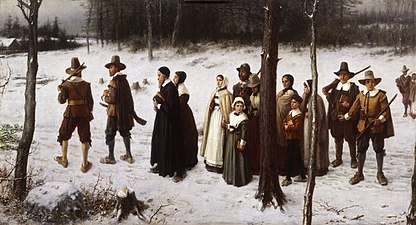
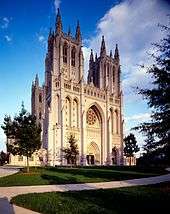

.jpg)
